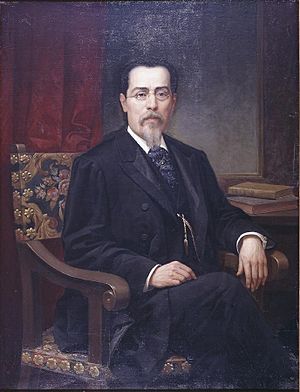Manuel Tamayo y Baus facts for kids
Quick facts for kids
The Most Excellent
Manuel Tamayo
|
|
|---|---|

Portrait at the National Library (1892)
|
|
| Born |
Manuel Tamayo y Baus
15 September 1829 Madrid, Spain
|
| Died | 20 June 1898 (aged 68) Madrid, Spain
|
| Seat O of the Real Academia Española | |
| In office 12 June 1859 – 20 June 1898 |
|
| Preceded by | Juan González Cabo-Reluz |
| Succeeded by | Emilio Ferrari |
Manuel Tamayo y Baus (born September 15, 1829 – died June 20, 1898) was a famous Spanish playwright. He wrote many plays for the theater.
Contents
Life of a Playwright
Manuel Tamayo y Baus was born in Madrid, Spain. His family was very connected to the theater. His mother, Joaquina Baus, was a well-known actress. Manuel wrote his first play, an adaptation from French, when he was just twelve years old! His mother even acted in it.
Early Career and First Successes
Thanks to his uncle, Antonio Gil y Zárate, who was a minister of education, Manuel got a job in the government. This helped him be financially independent. His early plays included Juana de Arco (1847), which was based on a work by Friedrich Schiller. Another early play was Una Aventura de Richelieu.
His play Angela (1852) was inspired by Schiller's Kabale und Liebe. However, Manuel made it his own. He gave it a Spanish setting, created original situations, and wrote all the dialogue himself.
Rising to Fame
Manuel's first big success was Virginia (1853). This play was known for its clever ideas and beautiful language. In 1854, he lost his government job when a new Liberal government took power. But he was soon given his job back by Cándido Nocedal, a minister who was impressed by Manuel's talent.
He worked with Aureliano Fernández-Guerra y Orbe on La Ricahembra (1854). This was a historical play that reminded people of the strong writing style of Lope de Vega. His play The Madness of Love (1855) made him Spain's leading playwright. This play featured Juana la Loca, the passionate daughter of Isabel the Catholic, as the main character.
Some of his other plays from this time included Hija y Madre (1855), which was not as successful. La Bola de Nieve (1856) was noted for its excellent craftsmanship.
Later Works and Challenges
Manuel sometimes had to adapt plays from French authors because he needed the money. For example, Lo Positivo (1862) was based on a French play. Del dicho al Jiecho (1864) came from La Pierre de touche. He also improved upon a French play to create Más vale Maña que Fuerza (1866).
The revolution of 1868 caused Manuel to lose his job at the San Isidro Library. This event indirectly led to his play No hay mal que por bien no venga (1868). This was a clever adaptation of a French play called Le Feu au Couvent.
During these years, Manuel wrote only one original play, Lances de Honor (1863). This play was about how bad dueling was, which led to many public discussions. It was written in prose and had a strong sense of old-world religious feeling. Many critics thought Lances de Honor was his best work. However, others believe Un Drama nuevo (1867) was his masterpiece. In this play, he bravely put famous figures like William Shakespeare and Yorick on stage.
Final Years and Legacy
Los Hombres de bien (1870) was Manuel's last play for the Spanish stage. He spent his final years rewriting his play Virginia. The updated version can be found in his collected works, published after his death.
In 1858, Manuel Tamayo y Baus became a member of the Spanish Academy. He later became its permanent secretary. In 1884, he was appointed director of the National Library by the minister Alejandro Pidal y Mon.
Images for kids
See also
 In Spanish: Manuel Tamayo y Baus para niños
In Spanish: Manuel Tamayo y Baus para niños


